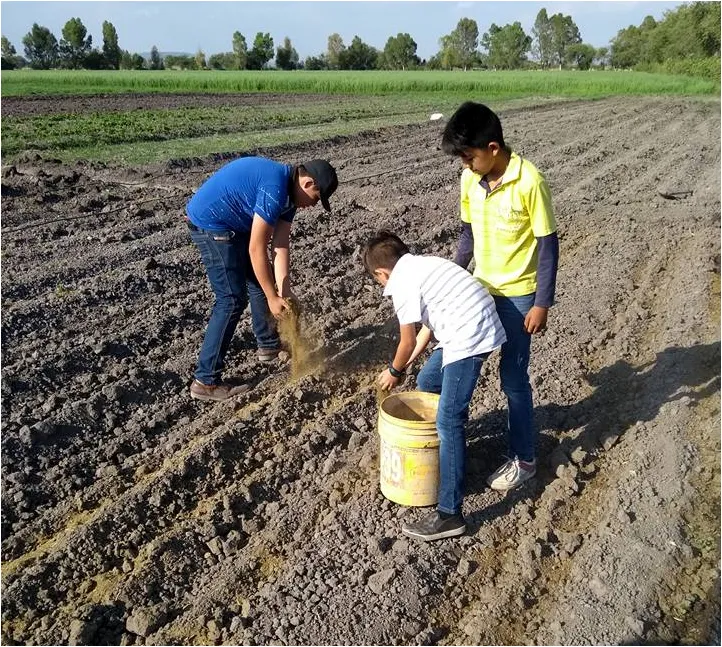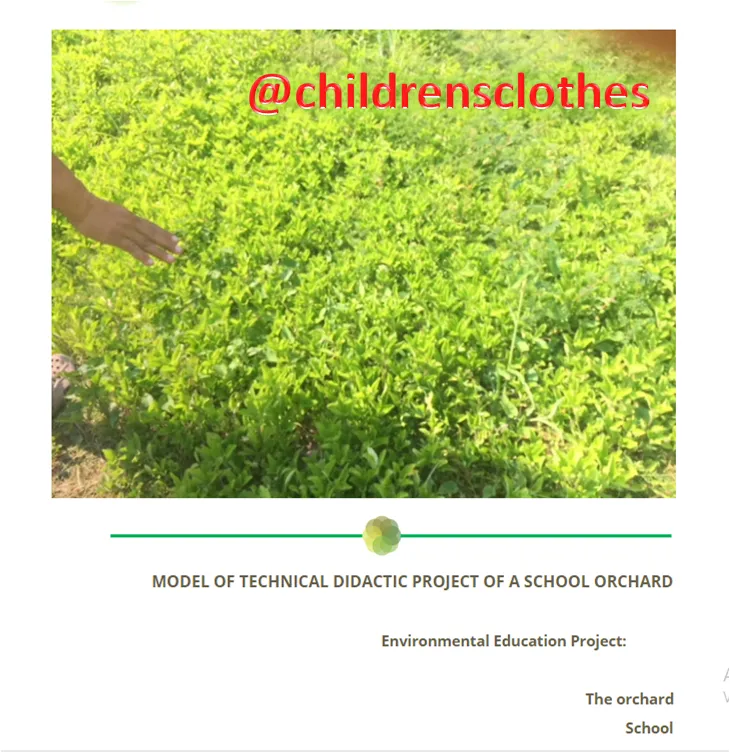Today we want to continue sharing classes about school gardens with you.

WHO WILL HELP US?
Engage the family and the community
Goals:
• Get local support
• Form the Garden Group
• Get support and maintain interest
• Select means of advertising diffusion
The school gardens are much more satisfactory when the community is interested and committed; and it would be desirable that participate from the beginning in the planning of the garden, because in this way a commitment will be forged, the workload, errors will be avoided and interest in the school activities.
Maybe you need to convince the community. The objectives and principles must be clearly communicated from the beginning. Above all, community members should make clear that the garden is designed for the benefit of children and the school as a whole, both in its physical aspect as educational and psychological.

A.- WHO CAN BE INTERESTED AND HOW CAN IT BE AWAKENING THE INTEREST OF PEOPLE.
Below are some groups of the community that could be interested in the school garden. Which of them could you go to in your community? What could it consist of?
the contribution of these groups?
Parents and families Parents and families will be interested in the school garden if they consider the garden an element
valuable for your children. Parents can, individually, Volunteer, and help with farming. The families can represent a market for the products of the school. They can also help children with their
«Garden duties», visit the garden and participate in talks, demonstrations, food fairs, celebrations or presentations.
Orchard work can also be taken home with the agreement of the family and with their help. For example, if there is not much space at school, children can learn the notions of horticulture at school, but create their own gardens
at home following the model that has been taught.
It is necessary to make the garden known to as many families as possible, inviting them to visit the garden with their children and giving them the opportunity to talk about the garden and make suggestions. It is useful to take advantage of your experience and your abilities.
What can volunteers do?
Organize a field day, or a day to clean the garden.
Build a shed, a fence or a wall.
Demonstrate horticultural and food preparation techniques.
Provide transportation, seeds, tools or recipes.
Help cook, dig, plant or clear.
Talk with the children about what they are doing in the garden.
Joint efforts
Maybe some parents think that their children should not get their hands dirty. To overcome this resistance, it is better to act calmly, little by little, giving importance to the work of horticulture and letting it appreciate. Participate yourself in the garden, along with well-known local people who endorse their performance. Get the school known for its garden, and for children to enjoy what they are doing and feel proud.
Some parents can not participate because they simply already have a lot of work, either because they are busy executives or because they are farmers who work long hours. It is necessary get them to invest their efforts in the garden in a modest way, for example by donating some seeds or some type of household waste for the compost. Any contribution is a commitment.
The community The local community as a whole certainly knows as much horticulture as you do. The human resources of the area where you live will generally reveal a rich source of knowledge and experience. (Cederstrom, 2002)
• Get in touch with well-managed family gardens near the school, and ask for help from gardeners. Perhaps they are willing to show the garden to the children and to teach them cultivation techniques or to donate seeds, seedlings, seedlings and cuttings.
• Go to prominent people in the community who have gardens, or who have managed to live well thanks to horticulture. Ask them to go to school and talk to the group that grows the garden, or invite a group of children to their garden. This
It will reinforce the image that children and their families have of horticulture. If the participants are former students of the school, the effect will be even greater.
• Encourage youth organizations, such as scouts and sports clubs, to devote an afternoon to the general cleaning tasks of the garden. Offer them some educational element and a snack.
School staff In most school gardens
that work properly, all school personnel are interested and lend a hand. Both teachers and others
Staff members can contribute:
• The home economics teacher can advise on
nutrition, hygiene and preparation and conservation of food.
• Business administration professors can teach on methods of sale, commercialization and accounting.
• Other teachers can use the garden for their subjects, because the orchards are especially valuable observatories for
sciences, mathematics, environmental studies and technologies, and a good stimulus to produce descriptions
written.
• School custodians or gardeners should also participate from the beginning. They know the school environment well, they have knowledge and practice, and they are always in school.
• School chefs should of course be consulted.
Non-governmental organizations (NGOs), aid agencies, sponsors, charities and church groups.
• Specialized NGOs can help with funds, supplies, advice, information or education.
• Private sponsors, for example local companies, are usually willing to offer a contribution if they are contacted politely, if they understand the project and if they get a little of advertising.
• Charitable institutions and groups of local churches reach large audiences. It is convenient to ask them for voluntary help or donations (for example, canning jars, boards for garden signs or sawdust for the trails). They have a good audience to organize talks on school gardens and they can also spread the good reputation of the school.
Advertising media and products Include newspapers local and radio, and also places where posters can be hung or where talks can be given, for example, the teachers' center, the local clinic, the market, the cinema or the meeting places of the local groups.
Are there regular events (for example, a science fair, an event sports, a day of graduation at school or end of course) where the good results achieved in the garden could attract attention?
THE GROUP OF THE GARDEN
What kind of group can unite people to support the garden? That depends on local communications, on the relationship of the school with the community, on how you prefer to work (for example in groups or individually), groups that already exist (for example, associations of parents and teachers, school councils) and how they work, and the preferences of the head of the garden.
These are some of the possibilities: which of them could work best in your situation?
• In informal networks, garden managers and children maintain personal contacts with active people who help them. Networks work well when managers have a facility for social relationships.
• A group of «Friends of the Garden» is a group of friends who visit the garden on a regular basis. They are invited to horticultural events and meet once or twice a year with schoolchildren and teachers to discuss how to provide help.
AS COLLABORATORS AS A PUBLIC
Advice, collaborations, information, interviews and expert demonstrations Financing, sponsorship, awards, improvement of situation Help, facilities, supplies, material of disclosure, equipment, advertising Through articles, duties, demonstrations, food exhibition fairs, guided tours How to interest the community?
Community groups
Parents and families
The community, the general public
School staff Local food industry:
(chefs, farmers, stores, services of meals, vendors) Lunch service
School Public services (health, agriculture, environment, town hall,
water supply service, etc.)
NGOs, aid agencies, churches, charities Local media and advertising products
• A Garden Club includes children, teachers and volunteers, who meet once a week to work, discuss and share a snack.
• A group of parents, who help in the activities of the class.
• An official committee, which meets every month or every two months and includes children, parents and representative members of the school, the community, the town hall, public services (health, agriculture, education) and the school lunch service.
• Special working networks with local groups, such as the group of young farmers, or a group of young people, or a farmers' association or a horticultural women's club.
Once the support of the community has been obtained, we must know how to maintain it. The collaborators need as much motivation as the students, the teachers and the managers themselves.
Remember: Students can do most of the advertising work Everyone learns better by teaching.
For example, children can:
• share home garden duties with their families and keep them informed about horticultural activities;
• design posters and prepare samples and presentations;
• document, with graphic and written material, the events of the garden (drawings, photos, plans and maps), and thus contribute to the garden file;
• place signs and put up signs to identify different crops.
Today we leave this link for you to download MODEL OF DIDACTIC TECHNICAL PROJECT OF A SCHOOL GARDEN, as a contribution of @childrensclothes for professors and teachers
Click on the image:


Reference:
Chauliac, M., Barros, T., Masse-Raimbault, A.M. y Yepez, R. 1996. Huertos escolares en el medio
rural andino. Alimentación, Nutrición y Agricultura, 16: 14-22.
In our next message we will include a complete procedure of the school garden implemented in a local school.
This project is linked to the @sc-v GREEN FOOTPRINT campaign.
Contact Data.
In addition we will have channels available for questions, suggestions and personalized attention through email and discord.
vastgaocasademodas@hotmail.com
xioreromero@gmail.com or chat with @childrensclothes#7556 on our Discord
You can also enjoy updated information on events and models from our Aurora collection, follow the Instagram account: Vastagocasademodas.
We accept payments in Cryptocurrencies Steem, Sbd.
Why support @childrensclothes?
By supporting this productive social program will be contributing to a solidarity project for children in Venezuela who have no shelter, food and medicine, will be strengthening the productive apparatus and the ability to generate jobs to mothers head of households, will also contribute to maximize the level educational with training for entrepreneurs in various trends, financial, commercial, business, personalized courses, will also be promoting the inclusion of special children Autism, Down syndrome, and children with cancer that occupy a special place. Preventive measures to care for the environment The use of the blockchain will be established as a technology with purpose, and to empower leaders in action to form their own companies, in a self-sustaining model through efficient resource management.
"If society improves, it will improve the performance of the company. You can not be happy alone, I can not do well in the middle of a failed society "
FASHION WITH PURPOSE: THE BEST COAT, IT'S LOVE
YEAR 2019. The goal is to enjoy childhood in all its colors, aromas and flavors.
We thank our collaborators:
@fundition,@adollaraday, @pennsif, @sc-v,@wafrica,@ecotrain, @curie,@c-squared,@artemislives,@gogreenbuddy.


